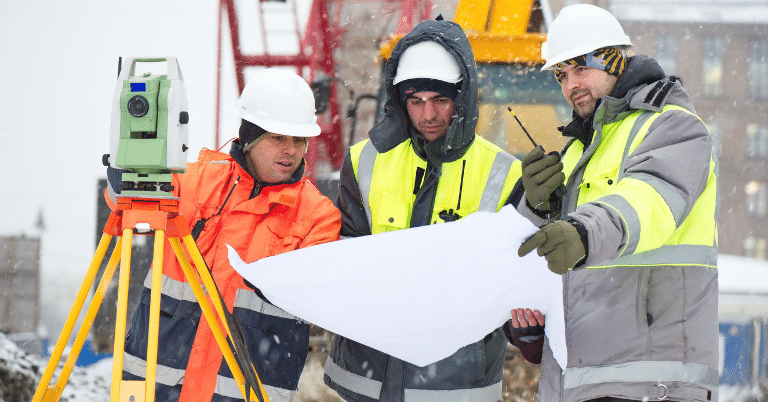
Request Free Consultation
To get answers to questions about your injury, contact Catalano Law for a FREE case evaluation. We’ll assess your case, explain your legal options, and recommend the next steps at no cost. We’re here when you need us.
Contact Form
General Contact Form

As the chill of winter descends upon Central New York and the Southern Tier, safeguarding the well-being of workers braving the bitter cold during their duties becomes critical.
Employers are responsible for protecting their road crews, construction teams, and any other employees or workers who work outdoors from the health hazards of cold-related injuries, ensuring a safe working environment amidst the severe winter conditions.
Dangers to Workers in Cold Temperatures
Working in extreme winter conditions exposes employees to various cold-related injuries and illnesses. Understanding the signs and symptoms of these conditions is essential for early detection and prevention.
- Frostbite. Frostbite occurs when the skin and under layers of tissue freeze, causing damage and cell death. Signs of frostbite include numbness, tingling, pale or hardened skin, and pain in affected areas. Severe frostbite can result in tissue loss or amputation.
- Hypothermia. Hypothermia is a life-threatening condition in which the body is unable to create heat faster than it loses it, resulting in a dangerously low body temperature. Hypothermia can cause shivering, confusion, fatigue, slurred speech, and uncontrollable shivering.
- Frostnip. Frostnip is a less severe cold injury that affects the top layers of skin and can lead to frostbite if not treated promptly. Symptoms include numbness, tingling, and skin discoloration, typically in the fingers, toes, nose, or ears.
- Trench foot: Trench foot results from prolonged exposure to wet and cold conditions. Symptoms include numbness, tingling, pain, and swelling in the feet. Left untreated, it can lead to tissue damage and gangrene.
- Chilblains. Chilblains are painful, itchy swellings on the skin that occur due to repeated exposure to cold but non-freezing temperatures. They often affect the fingers and toes and can cause temporary limited mobility.
Employers: You Have a Responsibility to Employees Working in the Cold
Employers have a legal and ethical responsibility to protect their workers from the adverse effects of extreme winter conditions. This duty extends to providing a safe work environment and taking steps to safeguard employees who work outdoors during the winter months.
- Conduct a cold hazard assessment. Routinely assess the worksite to identify potential cold-related hazards and risks. This includes evaluating exposure levels, wind chill factors, and the duration of exposure to cold temperatures.
- Provide appropriate personal protective equipment (PPE). Supply workers with suitable cold-weather gear, including insulated clothing, gloves, hats, and waterproof boots.
- Implement worksite controls. Take measures to minimize exposure to cold, such as scheduling shorter shifts or frequent breaks in warm areas and using windbreaks or shelters to protect workers from harsh winds.
- Ensure proper training. Offer workplace training on how to work safely in cold weather, including the recognition of hypothermia and frostbite symptoms.
- Encourage hydration and proper nutrition. Workers need access to warm liquids, such as tea, coffee, water, or broth, and access to high-calorie foods during breaks to maintain energy and warmth.
- Plan for emergencies. Have procedures for responding to cold-induced injuries and illnesses, including immediate first aid and medical care.
- Foster a culture of safety. Encourage workers to look out for one another and to report signs of cold stress immediately.
Workers: What You Can Do to Protect Your Health and Advocate for Your Rights
While employers are responsible for worksite safety in extreme winter conditions, employees can also take steps to safeguard their own health. If you work outside in the winter, do the following to protect your well-being and your rights:
- Dress appropriately. Wear layered clothing to trap heat, ensuring the outer layers are windproof and waterproof. Use moisture-wicking materials like wool or microfiber to keep sweat away from your body. Cover extremities with gloves, hats, and insulated footwear.
- Take regular breaks. Take breaks in warm, sheltered areas to allow your body to recover from cold exposure. Hydrate and consume warm beverages to maintain body temperature.
- Know your rights. Familiarize yourself with New York’s labor laws and regulations regarding workplace safety and break allowances. If you believe your employer is not meeting their obligations, raise concerns with your supervisor or HR department. If your concerns are still ignored and you suffer a cold-related injury or illness as a result, it may be time to get a lawyer involved.
- Seek medical attention. If you or a coworker experiences symptoms of cold-related injuries, seek immediate medical attention. Early treatment can prevent further damage and complications.
Seek Legal Counsel After a Workplace Injury
If you’re hurt on the job due to harsh weather conditions, you may be entitled to workers’ compensation benefits. Our New York workers’ comp lawyers at Catalano Law can help you file a claim with your employer to receive coverage for medical costs and lost wages caused by your injuries.
If your initial claim is denied, we can help you with the appeals process for a fair workers’ compensation settlement. Contact us today to schedule a free case review where we can discuss your claim, help you understand your rights, and get you fair coverage for work-related injuries.

